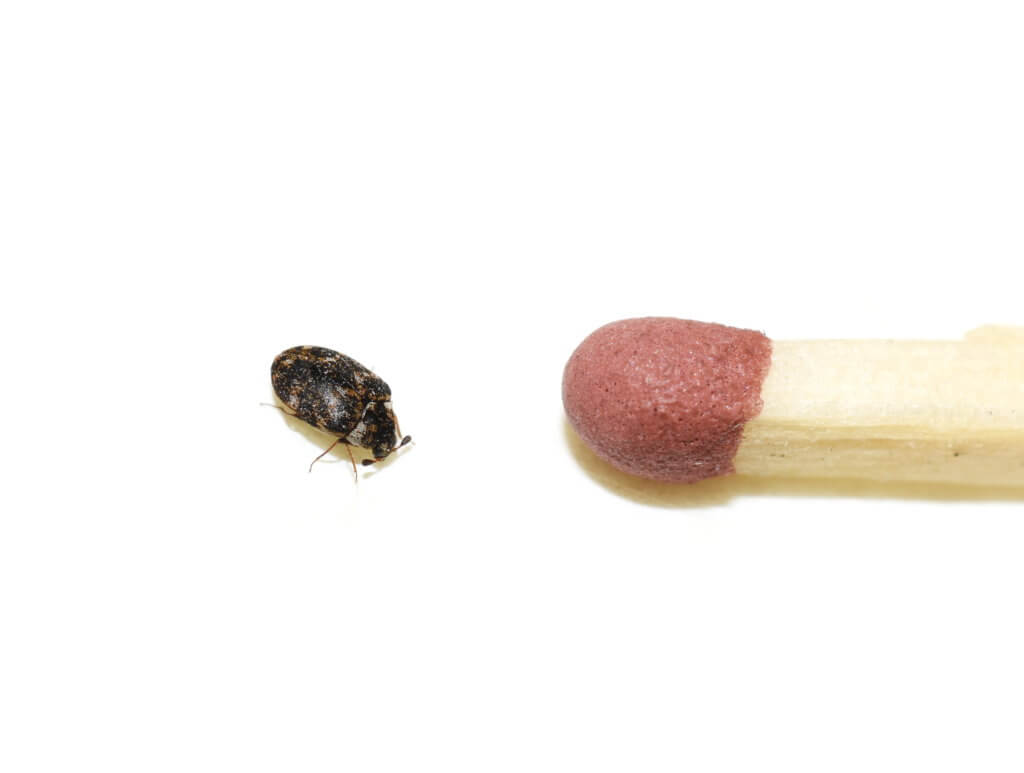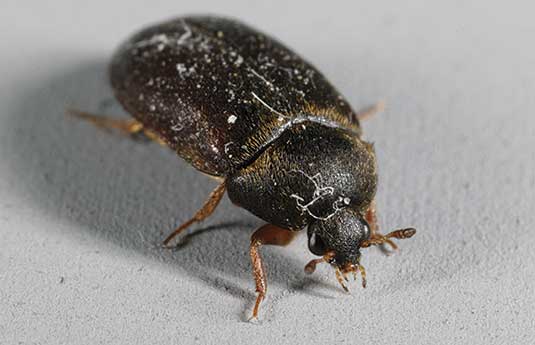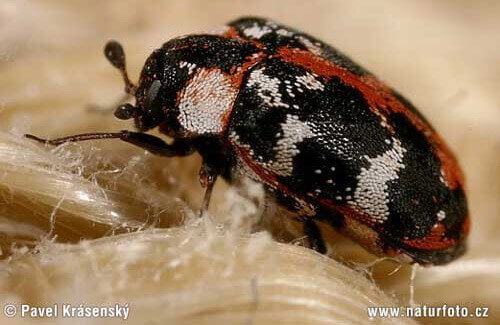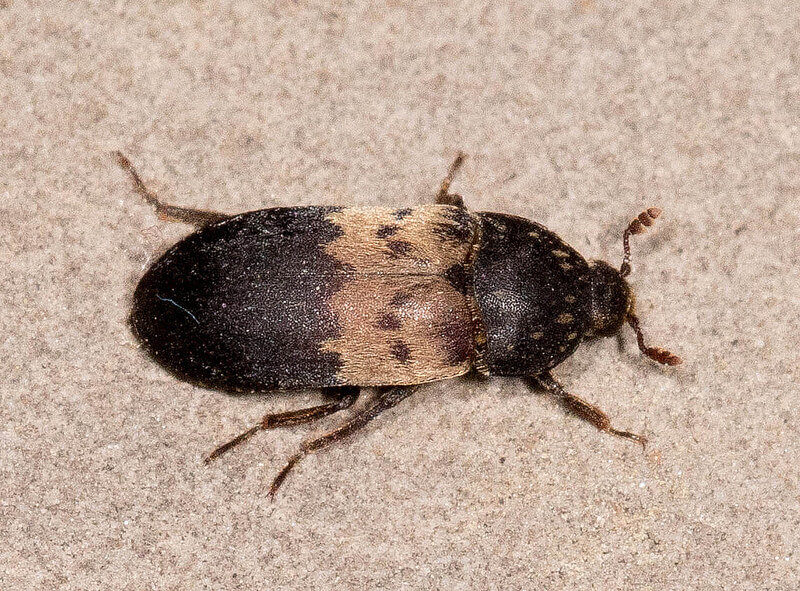Carpet beetles in the New England area can be quite a nuisance. And it’s not just one carpet beetle. There are several different types of carpet beetles in New England you could encounter. We don’t get all types of carpet beetles, but we do have a few of them! Knowing what the different species look like will help you identify them but calling in a pro is always preferable for this tiny bug.
What Do Carpet Beetles Look Like?
While the adult insects are typically round or oval in shape, each carpet beetle species has a unique look. While that sounds nice, it’s just more to deal with when you’re identifying them. Fortunately, we can help! When you’re trying to identify which kind of beetle you have in your home, look for these characteristics to help tell them apart.

Varied Carpet Beetles
Adult varied carpet beetles are about one-tenth of an inch in size when fully grown. Go look at an inch on a ruler. Break it into 10 smaller pieces. That’s how small varied carpet beetles are! No wonder they get missed often. This type of beetle has white and yellow splotches across its body, but coming in at such a small size, it would be difficult to see the colors without a magnifying glass. The varied carpet beetle larvae are teardrop-shaped and covered in rows of light brown hairs – and even smaller than the adults!
Black Carpet Beetles

Photo Courtesy of K.S. Matz
Black carpet beetle adults are typically a little larger than the varied species coming in at a whopping 1/8 to 3/16 inch long. Not all that huge. The pests’ bodies are more oval than round in shape. Their coloring ranges from dark brown to dull black, which would account for the name!
Common Carpet Beetles

The common carpet beetle is slightly bigger than a varied carpet beetle but not all that much bigger! They have a black head and a scaled, oval body. Their scales form red, orange, and white patches of color in a clear pattern so at least they are easy to distinguish from the black carpet beetles.
Larder Beetles

Photo Courtesy of Mark Etheridge
This dark-brown beetle is around one-third of an inch in length when mature. Larder beetle wing cases have six dark spots within a band of yellow. Underneath, their bodies and legs have a covering of pale-yellow hair (as if you’re going to turn them over to find out). Larder beetle larvae are brown with two distinct curved spines on their last body segment.
How Can I Tell if I Have a Carpet Beetle Problem?
Unlike some other pests, seeing one or two carpet beetles or larvae around your New England home doesn’t necessarily mean you have a problem with these insects. If you have an infestation, you’ll notice adult carpet beetles gathering around windowsills, near freshly cut flowers, in food storage areas, or around fabrics. Vacuuming often can help but if you have a large infestation you may need to bring in a pro. Here are some of the signs that you may have a serious issue:
Damage: Holes in woolen clothing, rugs, or blankets and bare spots in fur items often indicate that carpet beetle larvae are feeding in your home. Contaminated pet food and holes in packaging may signal a larder beetle infestation. Unfortunately, both of these signs can also be signs of other pests like clothes moths or Indianmeal moths. That’s why bringing in a pro is worth it.
Larvae: There are several types of carpet beetles including the varied carpet beetle, black carpet beetle, furniture carpet beetle, and common carpet beetle, which means there are several types of carpet beetle larvae. Carpet beetles of all species cause the most damage when they are in the larvae stage.
Large Groups of Adults: Spotting big groups of carpet beetles in different places in your home obviously indicates a more serious issue.
Discarded Skins: Both carpet and larder beetle larvae molt multiple times. If you have a large amount of them, you will probably see their cast-off skins in infested areas.
Eggs: Carpet beetles lay batches of 20 to 100 eggs in air ducts, on upholstered furniture, or in places where lint builds up in your home. The eggs are oval and may be either white or cream in color. Carpet beetle eggs usually go undetected since they’re tiny and blend in well with their surroundings. But just because you don’t notice them doesn’t mean they aren’t there. A trained eye is needed to find carpet beetle eggs.
How Do Carpet Beetles Get Inside Homes and Businesses
Adult carpet beetles can get into homes just like all pests: through open doors and windows. In addition, they can hitchhike in on jackets and backpacks unbeknownst to the owners. Carpet beetles can also invade buildings on wool clothing, rugs, and other secondhand items brought home from thrift stores. They lay eggs in woolen fabrics and small hidden crevices and because of the location of the eggs, can be overlooked easily. Larder beetle larvae attack stored goods and can easily bore into bags of pet food, often entering homes through these contaminated products.
Since meat and cheese attract immature larder beetles, supermarkets and commercial kitchens are at high risk. Think about it – it’s why we go there, too. Hard to blame them. Clothing stores and dry cleaners may be at more risk of issues with carpet beetle larvae since leather and wool make good meals for them. Warehouses that store rugs and merchandise made from animal hides, fur, or feathers can also attract these pests. Once in there, they can chew through all those fabrics as well as your bottom line from product losses.
How Can I Prevent Carpet Beetle Infestations?
Keeping your New England home or business clean can help prevent carpet beetle issues. Regularly vacuuming your carpeting, cleaning under your furniture, and sweeping baseboards will also help keep these insects at bay. If you have concerns about a carpet beetle infestation, contact an expert pest control company for assistance. You don’t have to just put up with them.